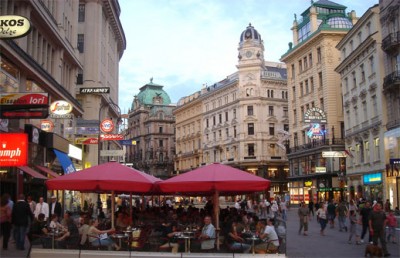Top’ cities in the world by quality of life, infrastructure

In order to to help governments and major companies place employees on international assignments, Mercer Consulting conducts an annual Quality of Living survey ranking and comparing 215 cities around the world by quality of life and infrastructure. When you look at the list, keep in mind that Mercer is a U.S. company.
Here’s their ranking of cities with the highest quality of life based on the following criteria: Political and social environment, economic environment, socio-cultural environment, health and sanitation, schools and education, public services and transportation, recreation, consumer goods, housing, natural environment (for more detailed criteria and a listing of the top 50 cities, go here):
1. Vienna, Austria
2. Zurich, Switzerland
3. Geneva, Switzerland
4. Vancouver, Canada
5. Auckland, New Zealand
6. Dusseldorf, Germany
7. Munich, Germany
8. Frankfurt, Germany
9. Bern, Switzerland
10. Sydney, Australia
11. Copenhagen, Denmark
12. Wellington, New Zealand
13. Amsterdam, Netherlands
14. Brussels, Belgium
15. Toronto, Canada
16. Ottawa, Canada
17. Berlin, Germany
18. Melbourne, Australia
19. Luxembourg, Luxembourg
20. Stockholm, Sweden
The cities with the best infrastructure based on electricity supply, water availability, telephone and mail services, public transport provision, traffic congestion and the range of international flights from local airports. This may be one of the best indicators of cities with potential to rise:
1. Singapore, Singapore
2. Munich, Germany
3. Copenhagen, Denmark
4. Tsukuba, Japan
5. Yokohama, Japan
6. Dusseldorf, Germany
6. Vancouver, Canada
8. Frankfurt, Germany
8. Hong Kong, China
8. London, UK
11. Sydney, Australia
12. Tokyo, Japan
13. Paris, France
14. Zurich, Switzerland
15. Bern, Switzerland
16. Montreal, Canada
17. Atlanta, USA
18. Toronto, Canada
19. Vienna, Austria
20. Hamburg, Germany
20. Helsinki, Finland
20. Oslo, Norway
20. Stockholm, Sweden
Notice that these cities are predominantly pedestrian-oriented. Coincidence?
Cafe street scene in Vienna, Austria by Orlando Bob.

Take away the Hartsfield airport, and there’s no way Atlanta shows up on the list of would-be risers. There may not be a less sustainable place on earth. They nearly ran out of water last year, and transportation is a complete disaster.
I was wondering about Atlanta myself, but I’m sure a lot of Atlantans have their own opinions.
It is pretty disturbing that the only US City anywhere near this list is Atlanta. Are we that bad at quality of life?
The ‘top’ U.S. cities in the Quality of Living survey are the following, of which Atlanta is not in the top 50:
28. Honolulu, USA
29. San Francisco, USA
35. Boston, US
42. Portland, USA
44. Washington DC, USA
44. Chicago, USA
49. New York City, USA
50. Seattle, USA
It just goes to show that there are a lot of cities in the world that aren’t in the U.S., but as far as the U.S. is concerned, the economic crisis is laying the groundwork for fundamental change – see How the Crash Will Reshape America.
Having lived in both Boston and Chicago, I have to dispute the order. The Boston T breaks down with ridiculous frequency compared with the Chicago “L,” and causes more disruption to transit time when it does. Also, Chicago has NOTHING on Boston in the area of traffic congestion. And rents in Chicago are 60 percent of what you pay in Boston.
I live in Auckland NZ and it should be nowhere near top 10 in anything except urban sprawl.
As a life-long Atlantan, I was surprised to see my city appear on the list of those with the best infrastructure above any other in the US. Kind of hard to believe, honestly.
Nonetheless, I certainly would defend my home town against any accusation that it’s a hellish pit of bad development and auto dependency. I live in Midtown with my wife and child and just this morning we walked down wide, pleasant sidewalks to the High Museum (which is adjacent to a MARTA train station) for a visit, then took a free shuttle bus to the Atlantic Station mixed-use development for lunch.
Atlanta’s a long way behind older European cities in regard to walkability and transit, but it’s not as bad as you might think. There have been some great improvements in the past few years, particularly in central Midtown.